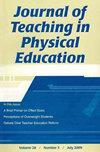基于模型实践的职前教师素养评估
IF 1.8
2区 教育学
Q2 EDUCATION & EDUCATIONAL RESEARCH
引用次数: 0
摘要
目的:本研究采用评估素养框架,探讨职前教师在早期实地体验中对信息系统的理解和制定。方法:6例患者采用SE季节,共540 min。采用7种定性资料方法。数据分析包括采用主题方法的演绎和归纳分析。可信度包括数据三角测量、同行汇报、负面案例分析和审计跟踪的维护。结果:从数据中得出的三个主要主题包括:教学决策由SE模型和非正式评估驱动;形式评价受SE结构驱动;评价价值高,评价素养低。讨论/结论:SE模型促使PTs使用正式的评估,但主要是以评估的方式。PTs缺乏评估素养,感到遵循模型的压力,没有使用评估来指导教学,并且担心未来的评估使用。本文章由计算机程序翻译,如有差异,请以英文原文为准。
Preservice Teachers’ Assessment Literacy Within Models-Based Practice
Purpose: Using the assessment literacy framework, the purpose of this study was to explore preservice teachers understanding and enactment of the message system during an early field experience. Method: Six PTs employed SE seasons totaling 540 min. Seven qualitative data methods were utilized. Data analysis included deductive and inductive analysis using a thematic approach. Trustworthiness included data triangulation, peer debriefing, negative case analysis, and the maintenance of an audit trail. Results: Three main themes derived from the data included: instructional decisions were driven by the SE model and informal assessment; formal assessment was driven by the structure of SE; and high assessment value but low assessment literacy. Discussion/Conclusion: The SE model drove PTs to use formal assessment, but primarily in an evaluative manner. The PTs lacked assessment literacy, felt pressure to follow the model, did not use assessment to inform teaching, and had concerns for future assessment use.
求助全文
通过发布文献求助,成功后即可免费获取论文全文。
去求助
来源期刊
CiteScore
4.20
自引率
21.40%
发文量
69
审稿时长
>12 weeks
期刊介绍:
The Journal of Teaching in Physical Education (JTPE) features peer-reviewed research articles based on classroom and laboratory studies, descriptive and survey studies, summary and review articles, and discussion of current topics of interest to physical educators at every level. JTPE is endorsed by the Curriculum and Instruction Academy of the National Association for Sport and Physical Education and the International Association for Physical Education in Higher Education.

 求助内容:
求助内容: 应助结果提醒方式:
应助结果提醒方式:


